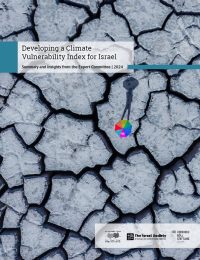The Expert Committee on Developing a Climate Vulnerability Index for Israel is a collaborative initiative between the Israel Society of Ecology and Environmental Sciences (ISEES), the Chief Scientist in the Israeli Ministry of Environmental Protection, and the Heinrich Böll Foundation. This joint effort aims to identify key vulnerability indicators for inclusion in Israel's national climate vulnerability index.
Israel is in a region classified as a hotspot area for climate change. Yet the expected impacts of climate change are not determined merely by the level of exposure to changing climate conditions, but also by the vulnerability and sensitivity of individuals, communities, and systems in the exposed areas. Vulnerable populations face greater risks: Without adequate adaptation efforts, climate change is likely to exacerbate social disparities, leading to increased social inequality.
Evaluating the vulnerability of communities and systems to climate change requires a thorough analysis of the unique vulnerability characteristics of different regions. To conduct such an analysis in a standardized and reliable manner, the development of a vulnerability index is necessary. This index would provide a comprehensive characterization of the various sensitivity characteristics (environmental, social, economic, and health) of different communities and regions. It would be based on existing databases readily available to authorities and research institutions, as well as on the collection of new data.
In essence, a climate vulnerability index is a methodological tool designed to organize existing information, select the most relevant and reliable data, and use a weighing key to process it into standardized values. This facilitates comparisons between different geographic units and the communities inhabiting them, thereby prioritizing the communities, sectors, and systems most vulnerable to climate change. Moreover, the use of an index supports concerted efforts to reduce vulnerability and enhance climate resilience.
A vulnerability index typically consists of three components: the exposure component, the adaptive capacity component, and the sensitivity component. Each of these components consists of a varying number of indicators, grouped into fields and clusters. The weighing process of all indicators produces a final value that represents the vulnerability level of a certain area to climate change. Choosing the indicators that comprise the index is the first essential and indispensable step in its development.
The aim of the expert committee is to characterize and select the most appropriate indicators, thereby establishing a scientific, professional infrastructure for developing a climate vulnerability index for Israel.

